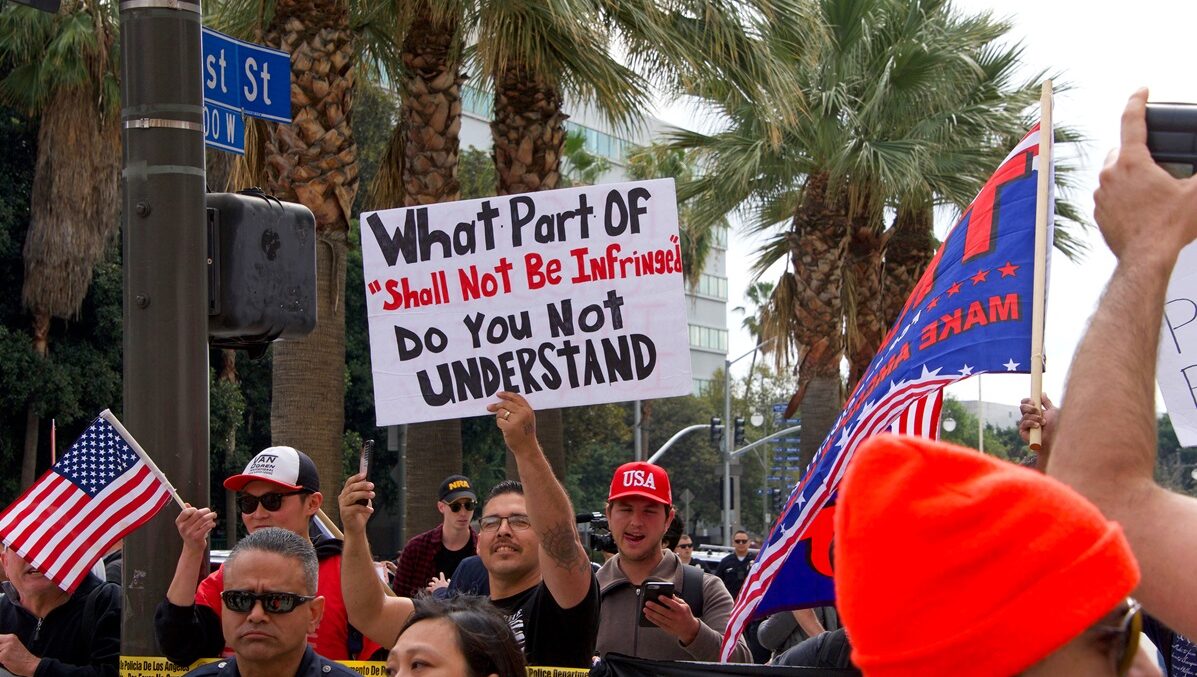
The U.S. Supreme Court delivered a major victory for free speech and struck a blow against government censorship-by-proxy yesterday in NRA v. Vullo: “Government officials cannot attempt to coerce private parties in order to punish or suppress views that the government disfavors.”
This is a major decision, and will have implications for free speech online, as the Court must soon consider similar facts in the social-media context in Murthy v. Missouri. But the case also illustrates the dangers that can attend government officials using even valid regulatory authority to strongarm private entities into doing things in ways they couldn’t do directly.
The Court’s unanimous opinion gets it right: “[A] government official cannot do indirectly what she is barred from doing directly… [she] cannot coerce a private party to punish or suppress disfavored speech on her behalf.”
How New York Leveraged Insurance Companies to Try to Silence the NRA in Vullo
It is an obvious feature of the First Amendment that the government can’t use its power to silence speech. But one way government actors have tried to get around this is by pressuring private entities through legal, and sometimes extra-legal, means to do their bidding.
Here, the New York State Department of Financial Services (DFS) and its then-Superintendent Maria Vullo made clear their intent to harm the advocacy efforts of the National Rifle Association (NRA) by strong-arming consent decrees from insurance broker Lockton Cos. (and its subsidiary Lockton Affinity LLC) and underwriter Chubb Ltd. (and its subsidiary Illinois Union Insurance Co.) in connection with the NRA’s “Carry Guard” program of personal firearms-liability policies, which were offered for more than a decade to NRA members. The basis for these consent decrees were allegations of technical and regulatory violations of New York insurance law, arguably none of which would be pursued in similar circumstances that did not involve a disfavored insurance client. (For more on the original dispute, see R.J. Lehmann’s June 2018 piece in National Review.)
‘Egregious Violation of Public Policy’
Vullo’s primary allegation against the NRA, Lockton, and Chubb was that the coverage offered by the Carry Guard program was “in contravention of New York Insurance Law” and “an egregious violation of public policy designed to protect all citizens.” The DFS consent order with Lockton notes several putative theories of why the coverage violated state insurance law, particularly highlighting that it offered “defense coverage in a criminal proceeding that is not permitted by law.”
And, indeed, Tit. 11 § 262.5 of the New York State Code does stipulate that “[n]o policy of legal services insurance may provide defense coverage in a criminal proceeding,” with a partial exception carved out for corporate directors & officers coverage. One problem, however, is that Carry Guard is not a legal-services insurance policy.
We know this is true both because the state’s definition of legal-services insurance (providing “for the payment of defense-only costs in relation to a claim of legal liability where a liability insurance policy cannot provide coverage for the legal liability of the insured”) does not describe the scope of coverage that Carry Guard extended, and also because, definitionally, the state code requires that:
No policy that includes legal services insurance may be issued or delivered except by an insurer authorized to write such insurance…
Chubb’s Illinois Union is not an authorized insurer; it is an excess-lines insurer. Indeed, the consent order describes the company as “an unauthorized insurer eligible to write excess lines insurance in New York State.” If the department’s view was that Carry Guard constituted a legal-services insurance contract, it could make the straightforward case that an excess-lines insurer may not write such a contract. Since it did not make that case, one must infer that it had a more nuanced theory (never articulated in the filings) as to why statutory restrictions on permissible coverage under a legal-services insurance contract written by an authorized insurer also apply to excess-lines policies written by unauthorized insurers.
It also bears noting that, in the years since the original consent agreements, both the City of San Jose, California, and the State of New Jersey have passed legislation that would, in fact, mandate that gun owners carry the kinds of liability insurance that Vullo contended were impermissible under insurance law (see R.J. Lehmann’s January 2023 piece on the subject in Insurance Journal). Similar legislation has also been proposed in New York State, both before and since 2018, with an active bill currently in the state Senate.
Insufficient Diligence
A second set of allegations lodged by New York argued that Lockton did not satisfy New York’s “diligent search” requirement before placing a policy in the excess-lines market. Surplus and excess lines are reserved for unusual coverages that are hard to place, and are accordingly regulated much less stringently for factors like rate and form (and even solvency). Under the diligent-search requirement, a broker must ask three authorized “admitted market” carriers—in essence, insurers who write standard lines of business like homeowners, auto, and workers compensation—whether they would write this kind of policy. If they all say no (providing “declinations”), then the broker may seek coverage in the surplus and excess lines market.
Here, the DFS stipulated that Lockton did perform diligent search for the NRA’s Carry Guard product, but that they did so only once per year. In the department’s view, the broker was actually required to obtain three declinations for each and every one of the 680 Carry Guard insurance policies that were issued to New York residents between April and November 2017—in contravention of common sense that the kind of coverage the product provided simply isn’t available in the admitted market.
And that is, indeed, the letter of the law. But it should be noted that the department possessed, and opted not to exercise, significant discretion regarding enforcement in this area. For example, DFS maintains an extensive “export list” of hard-to-place coverages that may be taken directly to the surplus and excess lines market, bypassing the declinations process entirely. These notably include coverages for shooting ranges, products-liability coverage for firearms manufacturers, and even liability coverage for security guards who use guns. It is therefore particularly notable that DFS very explicitly declined to add firearms-liability coverage of the sort provided by the NRA’s Carry Guard to the export list.
Unlicensed Insurance Broker
The DFS’ third significant allegation (there were several other more minor ones) was that, in marketing the Carry Guard program to its members, the NRA was serving as an unlicensed insurance producer (a “producer” is a term in insurance law for an agent or broker).
The Carry Guard program is commonly understood as an “affinity insurance” marketing arrangement, in which a club or other sponsoring organization offers an insurer or insurance broker access to market policies to its members. Such arrangements have long been common, with the best-known likely the AARP’s widely advertised home and auto insurance program, underwritten by The Hartford.
For its part, the NRA contended that it was simply the sponsor of Carry Guard, while Lockton was the producer (indeed, it was Lockton Affinity—the company’s unit devoted to affinity insurance—that managed the program). In many states, this would likely be uncontroversial. But while New York State has adopted the National Association of Insurance Commissioners’ Producer Licensing Model Act (PLMA), New York-area insurance attorney James Burnes notes that DFS has at times chosen to apply the PLMA in ways that may present “regulatory landmines”:
The NYDFS defines a “referral” as an advertisement that is framed by a recommendation, endorsement or promotion, by a non-licensee of the insurance product or service. An example of a referral is the distribution by a non-licensee of promotional literature providing information about how to purchase insurance through the licensee’s office. Another example is a nonlicensee’s maintenance of a website that endorses a particular insurance product.
. . .The two issues that present the most difficulty—distinguishing between allowable insurance referrals and impermissible solicitations, and determining allowable methods of payment for referrals—have been compounded by the advent of internet affinity sales models and unlicensed tech participants in insurance transactions.
The department appears, in this case, to have exploited this ambiguity to compel the NRA’s insurance partners into consent agreements that promised “not to participate in the Carry Guard Program, any similar programs, or any other NRA-endorsed programs with regard to New York State.” The result: the NRA was no longer able to offer a long-time benefit to its members, and its pro-Second Amendment advocacy was harmed as a result.
What This Means for Murthy
It is clear from the unanimous opinion in Vullo that the Court agrees that Bantam Books is the starting point for analysis when it is alleged that government officials coerced private entities into censorship. The analysis of such claims will be a fact-bound inquiry determining whether the government officials in question engaged in coercion, rather than persuasion. At the very least, this should deter government officials from openly engaging in censorship-by-proxy, as alleged in Vullo. But what does this mean for the allegations of coercion from the Biden administration against social-media companies in Murthy?
In some ways, the situation in Murthy is actually even more extreme than that of Vullo. For instance, the DFS could at least allege (however implausibly) violations of insurance law that resulted in the consent decrees at-issue. In Murthy, federal officials directly pressured social-media companies to suppress protected speech, with no basis in law whatsoever. Despite this, it doesn’t seem likely that we will have a unanimous opinion siding against the government in Murthy.
As explained in an earlier blog post analyzing the Murthy oral arguments, Justice Elena Kagan questioned whether plaintiffs have standing, asserting that the moderation decisions of social-media companies aren’t traceable to the actions of the federal officials. And both Justices Kagan and Brett Kavanaugh expressed doubts as to whether it is coercion for government officials to attempt to shape narratives in media without a direct threat of regulatory action.
But most distinctly, it seems like the Court would likely split over whether the facts alleged in Murthy satisfy the Bantam Books test for coercion, which has now been reiterated in Vullo. Notably, U.S. Solicitor General Elizabeth Prelogar filed an amicus on behalf of the NRA in Vullo (which was obviously, if indirectly, on behalf of the federal government in Murthy). Justices that expressed skepticism of the plaintiffs in Murthy could adopt the factual distinctions laid out in those briefs to find in favor of the government, while signing on to the opinion in Vullo.
There is reason for hope, however, for those concerned about online speech. The Court’s opinion in Vullo, written by Justice Sonia Sotomayor, expressed skepticism of exactly the sort of backroom dealing alleged in Murthy:
Yet where, as here, a government official makes coercive threats in a private meeting behind closed doors, the ‘ballot box’ is an especially poor check on that official’s authority.
And the opinion also makes clear that courts shouldn’t “tak[e] allegations in isolation and fail[] to draw reasonable inferences” in favor of the plaintiff. Thus, the allegations in Murthy of the overarching power of the federal government to investigate and regulate social-media companies should be considered as context for the alleged coercive acts of the federal officials.
Conclusion
The Supreme Court’s opinion in Vullo struck a blow against government use of pressure against private companies to censor the speech of others. But whether it will only apply to brazenly public attempts at coercion (like that in Vullo) is still an open question. The result should not be that the government can get away with such schemes if they are better about not creating a record for court review.





